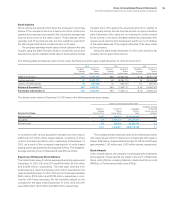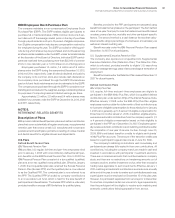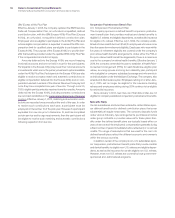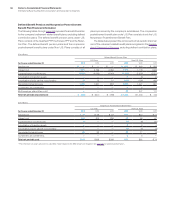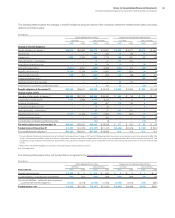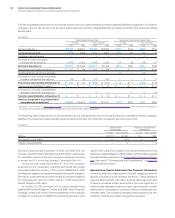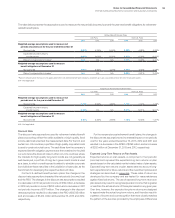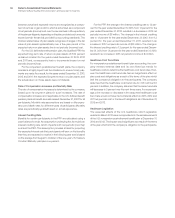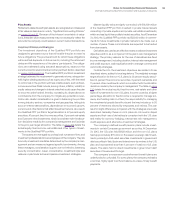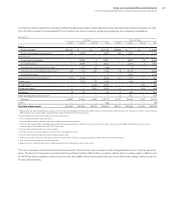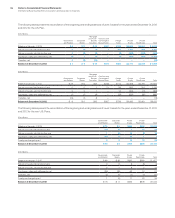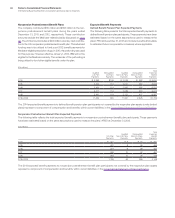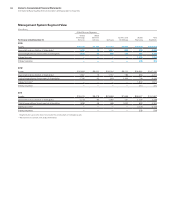IBM 2013 Annual Report Download - page 136
Download and view the complete annual report
Please find page 136 of the 2013 IBM annual report below. You can navigate through the pages in the report by either clicking on the pages listed below, or by using the keyword search tool below to find specific information within the annual report.
Notes to Consolidated Financial Statements
International Business Machines Corporation and Subsidiary Companies
135
Plan Assets
Retirement-related benefit plan assets are recognized and measured
at fair value as described in note A, “Significant Accounting Policies,”
on pages 91 and 92. Because of the inherent uncertainty of valua-
tions, these fair value measurements may not necessarily reflect the
amounts the company could realize in current market transactions.
Investment Policies and Strategies
The investment objectives of the Qualified PPP portfolio are
designed to generate returns that will enable the plan to meet its
future obligations. The precise amount for which these obligations
will be settled depends on future events, including the retirement
dates and life expectancy of the plans’ participants. The obliga-
tions are estimated using actuarial assumptions, based on the
current economic environment and other pertinent factors described
on pages 132 through 134. The Qualified PPP portfolio’s investment
strategy balances the requirement to generate returns, using poten-
tially higher yielding assets such as equity securities, with the need
to control risk in the portfolio with less volatile assets, such as fixed-
income securities. Risks include, among others, inflation, volatility in
equity values and changes in interest rates that could cause the plan
to become underfunded, thereby increasing its dependence on
contributions from the company. To mitigate any potential concen-
tration risk, careful consideration is given to balancing the portfolio
among industry sectors, companies and geographies, taking into
account interest rate sensitivity, dependence on economic growth,
currency and other factors that affect investment returns. As a result,
the Qualified PPP portfolio’s target allocation is 42 percent equity
securities, 47 percent fixed-income securities, 6 percent real estate
and 5 percent other investments, which is consistent with the alloca-
tion decisions made by the company’s management and is similar
to the prior year target allocation. The table on page 136 details the
actual equity, fixed income, real estate and other types of invest
-
ments in the Qualified PPP portfolio.
The assets are managed by professional investment firms and
investment professionals who are employees of the company. They are
bound by investment mandates determined by the company’s man-
agement and are measured against specific benchmarks. Among
these managers, consideration is given, but not limited to, balancing
security concentration, issuer concentration, investment style and
reliance on particular active and passive investment strategies.
Market liquidity risks are tightly controlled, with $6,809 million
of the Qualified PPP portfolio invested in private market assets
consisting of private equities and private real estate investments,
which are less liquid than publicly traded securities. As of December
31, 2013, the Qualified PPP portfolio had $2,830 million in commit-
ments for future investments in private markets to be made over a
number of years. These commitments are expected to be funded
from plan assets.
Derivatives are used as an effective means to achieve investment
objectives and/or as a component of the plan’s risk management
strategy. The primary reasons for the use of derivatives are fixed
income management, including duration, interest rate management
and credit exposure, cash equitization and to manage currency and
commodity strategies.
Outside the U.S., the investment objectives are similar to those
described above, subject to local regulations. The weighted-average
target allocation for the non-U.S. plans is 33 percent equity securi-
ties, 54 percent fixed-income securities, 2 percent real estate and
11 percent other investments, which is consistent with the allocation
decisions made by the company’s management. The table on page
136 details the actual equity, fixed income, real estate and other
types of investments for non-U.S. plans. In some countries, a higher
percentage allocation to fixed income is required to manage sol-
vency and funding risks. In others, the responsibility for managing
the investments typically lies with a board that may include up to 50
percent of members elected by employees and retirees. This can
result in slight differences compared with the strategies previously
described. Generally, these non-U.S. plans do not invest in illiquid
assets and their use of derivatives is consistent with the U.S. plan
and mainly for currency hedging, interest rate risk management,
credit exposure and alternative investment strategies.
The company’s defined benefit pension plans include invest-
ments in certain European government securities. At December
31, 2013, the U.S. plan held $828 million and the non-U.S. plans
held approximately $11 billion in European sovereign debt invest-
ments, primarily in AAA-rated securities. Investments in government
debt securities in Italy, Spain and Ireland were de minimis in the U.S.
plan and represented less than 1 percent of total non-U.S. plan
assets. The plans hold no direct investments in government debt
securities of Greece and Portugal.
The company’s nonpension postretirement benefit plans are
underfunded or unfunded. For some plans, the company maintains
a nominal, highly liquid trust fund balance to ensure timely benefit
payments.


